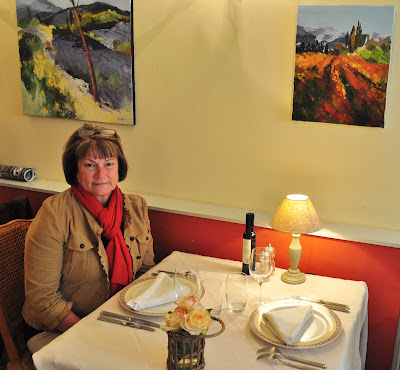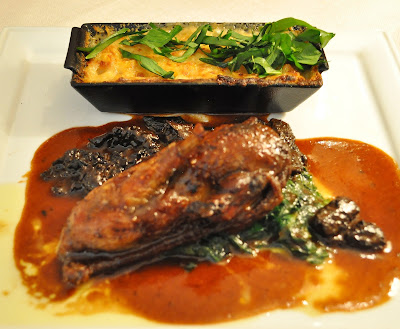About halfway to Grignan, we saw a sign announcing that the next village was Saint Pantaléon les Vignes, a small village with a population of 433 in the Drôme Provençale, the area between the Rhône River and the Alpes north of the Vaucluse.
 |
| Saint Pantaléon les Vignes |
Saint Pantaléon les Vignes sits at the foot of Lance Mountain surrounded by vineyards, lavender fields, olive groves and apricot orchards. Since we had not driven this way before or know anything about the village, we decided to stop and have a look around before continuing on to lunch. What caught our eye was the handsome Mairie (town hall) with its clock built in 1902.
 |
| The Mairie (town hall) of Saint Pantaléon les Vignes |
As indicated by the name of the village and the cork-decorated roundabout at the entrance to the village, the primary reason to make a trip to Saint Pantaléon les Vignes is for the local wine. I told you here, here, here, here, and here, how much we like roundabouts with decorations that tell you something about the village or town where they are located.
 |
| A roundabout decorated with corks at the entrance to Saint Pantaléon les Vignes |
As we walked around the village, we came upon the 11th century Saint Pantaléon les Vignes Church with its Romanesque bell tower.
 |
| The Saint Pantaléon les Vignes Church |
Stone houses line the narrow streets of Saint Pantaléon les Vignes. In the center of the village at Place du Village is the village fountain seen below.
 |
| The Saint Pantaléon les Vignes fountain |
Wine has a long history in the area going back long before 1918 when the town council voted to add the words “les vignes” (the vines) to the name of the village. Saint Pantaléon les Vignes was designated as an Appellation d’Origine Contrôlée (AOC) “Côtes du Rhône Villages" in 1969, one of 17 villages with this classification in the Southern Côtes du Rhône.
If you don't know, "Côtes du Rhône Villages" is a French wine Appellation d'Origine Contrôlée (AOC) in the southern Rhône wine region. This AOC consists of a list of villages around the region which supposedly produce a high quality of wine. It is above the more generic "Côtes du Rhône" AOC but below appellations such as Châteauneuf-du-Pape and Gigondas.
You might be interested to know that every year a ceremony is held in Saint Pantaléon les Vignes, where the oldest and the youngest wine producer, along with the village Mairie, decide when to begin the annual harvest of grapes.
 |
| Wine related "sculptures" at the entrance to Saint Pantaléon les Vignes |
Finished with our visit to Saint Pantaléon les Vignes, we were back on the road to Grignan. The village of Grignan sits on the flanks of a large rocky peak crowned by a large castle, formerly owned by Adhémar de Monteil. The medieval village is a labyrinth of picturesque, winding streets and shaded squares. There are 1,521 people who reside in Grignan.
 |
| The village of Grignan and the Castle of Adhémar de Monteil |
Construction on the Grignan castle began in the 12th century, but it wasn't until the 13th century that the Adhémar family expanded it to a huge fortress. In the 17th century, François Adhémar de Monteil transformed the fortress into a luxurious residence. Reduced to ruins in 1793 during the French revolution, it was rebuilt in the early 20th century by Madame Fontaine who spent her entire fortune restoring the castle to its former grandeur. The castle now belongs to the Department of the Drôme.
 |
| The Castle of Grignan |
Farming plays a major role in local life and vineyards cover much of the area. Truffles are also a big business here. When some of the grapevines were killed off by disease in the 19th century, oak trees took their place and truffle hunters with their dogs in tow now search the area for black truffles - the countryside around Grignan accounts for 70% of France's truffle production. Another crop you see when you drive around the area is lavender - rows and rows of the fragrant purple plant are cultivated in the area.
 |
| A pretty restaurant near the car park in Grignan |
The ramparts (defensive walls) of Grignan were built in the 13th century. The circular protective wall included a dozen defensive towers and six entries (portes).
 |
| One of the narrow streets in Grignan |
Grignan became renowned in France during the 17th century when Marie de Rabutin-Chantal, the Marquise de Sévigné, a French aristocrat, famous for writing letters, wrote about Grignan and the surrounding area in her letters; Most were written to her daughter Françoise, who was married to François Adhémar de Monteil, Comte (Count) de Grignan.
Madame de Sévigné caught a "fever" and died in April 1696 at Grignan and is buried in the Collégiale Saint-Sauveur Church which was built below the Grignan castle terrace between 1535 and 1539. She is revered in France as one of the great icons of French literature.
 |
| A Grignan home courtyard with plants and flowers |
We found Le Poème de Grignan Restaurant in a village house in the historic part of Grignan. We came here because it was listed in the 2012 Michelin Guide to Bonne Petite Tables for earning a "Bib Gourmand" award for being a "pleasurable" restaurant that offers three courses for under 29 euros. As I have told you before, we have had very good dining experiences at "Bib Gourmand" restaurants.
 |
| Le Poème de Grignan Restaurant |
Le Poeme de Grignan Restaurant is owned by the chef Hervé Dodane and Valérie Chareyre who takes care of the front of the house. The dining room is pretty, decorated with the colors of Provence, roses for which Grignan is famous are set on each table. There is a single dining room which can accommodate 22 diners, so if you decide to go, make sure you get reservations.
 |
| Shirley pauses for a picture at Le Poème de Grignan Restaurant |
We chose the Menu Promenade Gourmande for 29 Euros with amuse bouche, starter, main course and dessert. We passed on the cheese course. As soon as we gave our choices to the server, we were brought a plate with Feuilletés à la tapenade (puff pastry with olive purée) and Gougères (cheese puffs).
 |
| Feuilletés à la tapenade and Gougères |
This was followed by an amuse bouche consisting of a soup verrine with a little parmesan cookie served by the chef to warm up our taste buds for the dishes to follow.
 |
| Amuse bouche |
I have to admit we drink rosé wine year around and we like to try them from the different villages we visit. Today was no exception; We chose a locally produced wine, the 2010 Domaine de Montine Gourmandises Rosé, a blend of Cinsault, Grenache, and Syrah.
 |
| Domaine de Montine Gourmandises Rosé |
Unfortunately, the phone with my notes about our meal was lost so I don't have all the details about the food we ate at Le Poeme de Grignan Restaurant that day. For starter, Shirley began with spring asparagus, blanched so it still had a bite and served with greens (instead of the smoke salmon on the menu) and strips of roasted red and yellow peppers.
 |
| Spring asparagus with greens |
I began with the same fresh asparagus served with pesto and smoked salmon.
 |
| Spring asparagus with smoked salmon |
For her plat (main course), Shirley chose a fillet of fish with spinach risotto.
 |
| Filet de Poisson et risotto aux épinards |
For my main course, I had a delicious magret de canard (duck breast) accompanied by a gratin. Unfortunately, I don't remember anything about the gratin or the sauce for the duck breast.
 |
| Magret de canard with gratin |
For dessert, I chose a trio of desserts that included a fondant au chocolat (molten chocolate cake) and ice cream.
 |
| Trio of desserts |
Shirley had what looks like an affogato café, an Italian dessert that consists of ice cream "drowned" in espresso.
 |
| Shirley's dessert |
At the end of a great meal, it's always nice when the chef sends out a plate of mignardises, tiny bite sized desserts, to enjoy before you head on your way.
 |
| Mignardises |
We will definitely return to Grignan, to eat at Le Poème de Grignan Restaurant, the food was great, and I want to see more of the village. I was happy to see Le Poeme de Grignan Restaurant was again awarded a "Bib Gourmand" in the just released 2013 Michelin Guide for offering three courses for under 31 euros.
Le Poème de Grignan Restaurant
Rue Saint-Louis
26230 Grignan
Tel: 04 75 91 10 90
www.lepoemedegrignan.com
Bonne journée mes amis et à bientôt.
What a beautiful lunch. Grignan is such a nice place, we often take visitors there.
ReplyDeleteAmazing how France is just filled with picturesque little towns. I love the tradition of the oldest and youngest winemakers getting to choose when the harvest starts - sounds very egalitarian! :)
ReplyDeleteCamille - I think that is very cool too that the winemakers get to choose the date to start the harvest each fall.
ReplyDelete